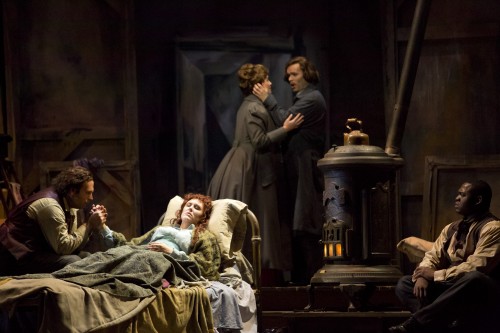Mood lighting: the death of Mimi in the opera La Boheme
Undertakers put a great deal of effort into making people who have died look good for when family members come to see them. There is, they feel, great therapeutic value in the experience of visiting someone who’s died, especially if they’re looking serene. They employ a range of cosmetic treatments to achieve a good ‘memory picture’. If the family is pleased with what they see, this reflects well on the undertaker’s duty of care. They are (relatively) happy customers.
But the fruits of the cosmetic work carried out in the mortuary are so often let down by the decor and especially the lighting of the chapel of rest. Most undertakers, when asked to demonstrate their lighting, adjust a dimmer switch — in other words they achieve the desired mood-effect not with light but with gloom. That gloom, taken together with the physical coldness of most chapels of rest, can make for a sub-optimal experience for the visitors.
Old fashioned tungsten bulbs, with their low colour temperature, shed a warm light at any intensity. But they’ve been outlawed, and undertaker must nowadays fit halogen and LED lamps with a much higher colour temperature — ie, a much colder white light. Result: it now takes even more gloom to mitigate their coldness in the chapel of rest.
I’ve only seen one chapel of rest which uses additive colour to light the chapel and, above all, the person who’s died. By mixing red, green and blue light it is possible to achieve a variety of effects (see pic below). If, for example, there is still evidence of jaundice in the face of the dead person, it is possible to counter that by careful colour-mixing. It works better than dimmed white light but leaves something to be desired if the quality of the equipment is not up to the job. It’s important to have the right kit.
Better still is to do what theatre lighting designers do and use colour filters. An actor of a certain age will always ask for pinky-lavender filters in the front-of-house lanterns because pinky-lavender flatters older skin.
Theatre lighting experts know all this. They know how to light human faces of all ages and, just as important, they know how to create mood onstage with subtle use of colour. Even to them, though, lighting a dead human face is likely to pose a challenge because the light does not encounter warm blood beneath the skin. They would have to experiment with their colour filters according to the age and condition of the dead person. They’d bring in ambient light from other lanterns in the chapel of rest. They’d crack it, for sure.
Shortly, the GFG will be working with a theatre lighting expert to transform the lighting in a chapel of rest. When we’ve done it, we’ll tell you what we did and show you before and after photos. If you’re an undertaker and you’re interested in a makeover in your own chapel of rest, do get in touch.




It sounds fascinating. We have just redecorated and refurnished our chapel and our lighting (due to lamps brought in from Keith’s house) are best described as ‘pinky/lavender’. We have decorated it in accordance with our own taste because we have found that works quite well 🙂